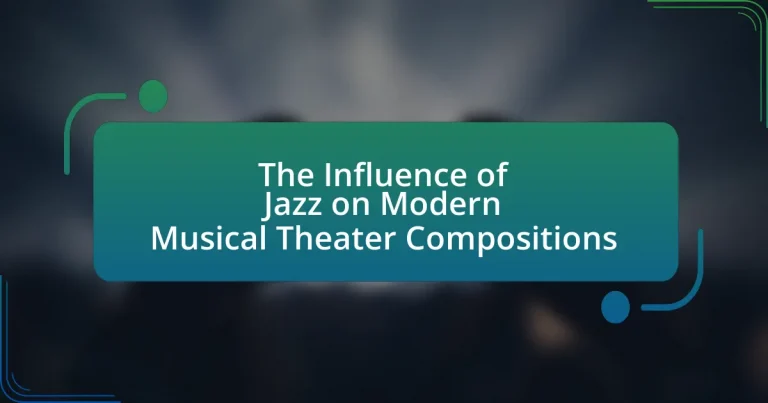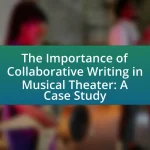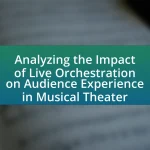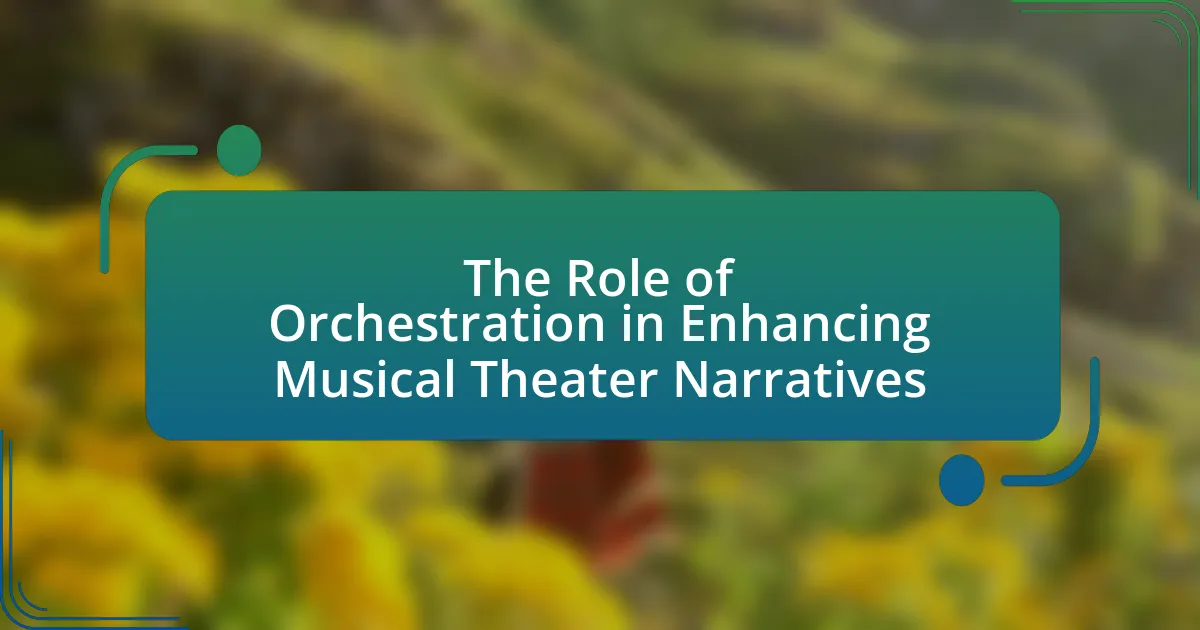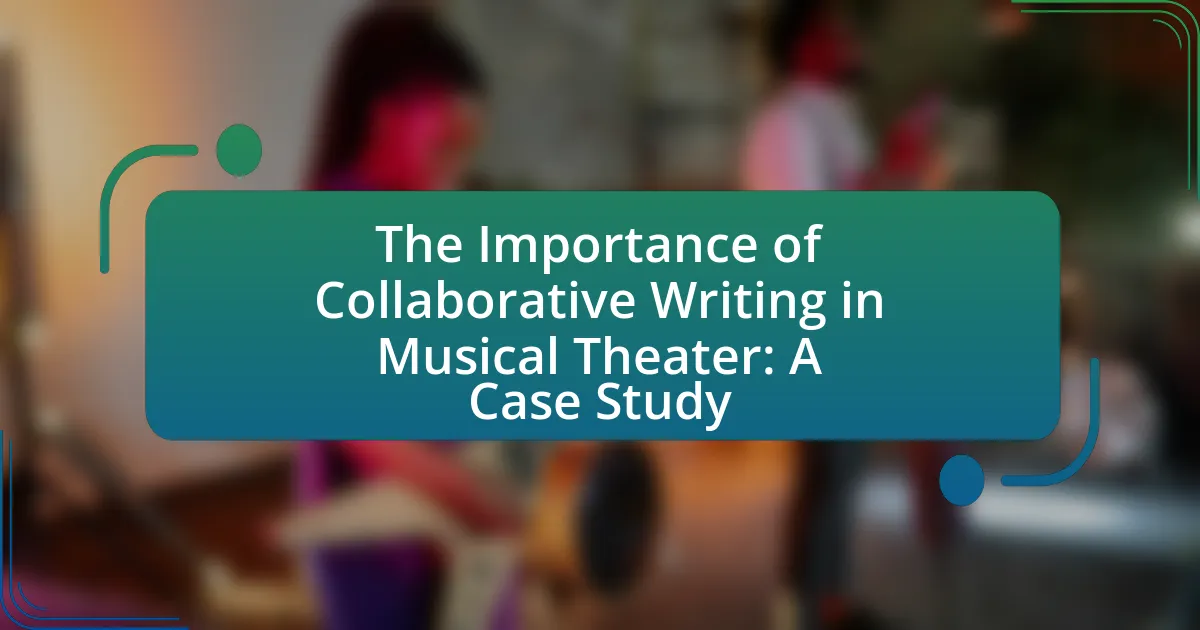The article examines the significant influence of jazz on modern musical theater compositions, highlighting its introduction of complex rhythms, improvisation, and unique harmonies. It discusses how jazz elements enhance storytelling and character development in contemporary musicals such as “Hamilton” and “Chicago.” The piece also explores the historical emergence of jazz, its key characteristics, and its impact on various musical genres, while addressing the integration of jazz in musical theater through notable composers and productions. Additionally, it considers the challenges and future trends in blending jazz with musical theater, emphasizing the role of technology and collaboration with jazz musicians in enriching theatrical experiences.
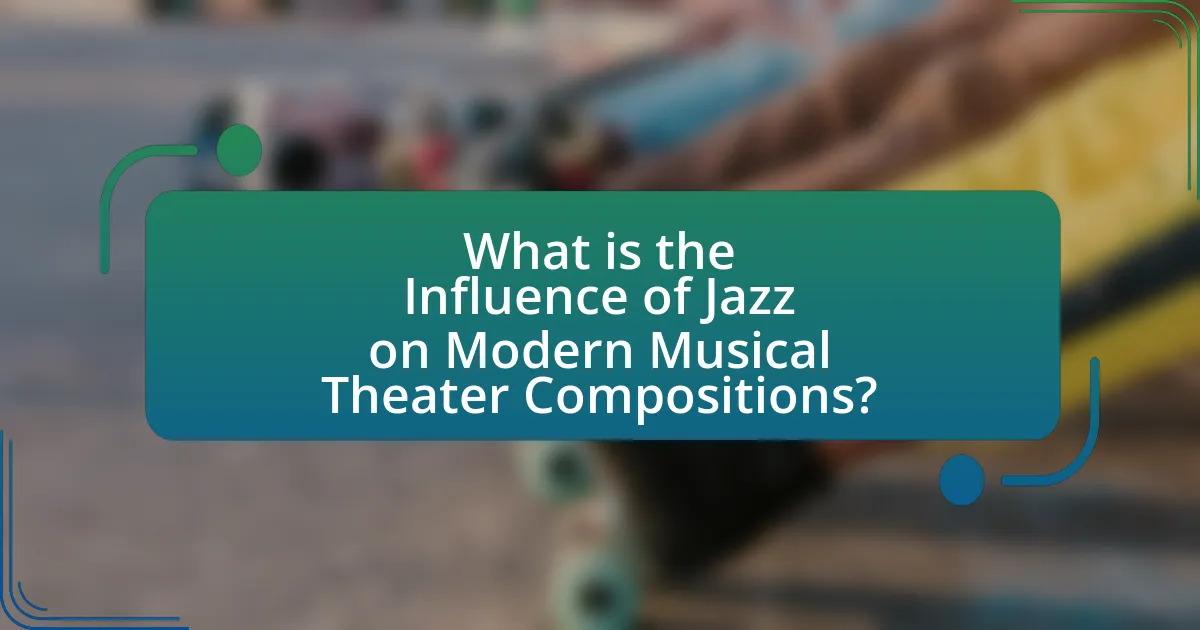
What is the Influence of Jazz on Modern Musical Theater Compositions?
Jazz significantly influences modern musical theater compositions by introducing complex rhythms, improvisation, and unique harmonies. This genre has shaped the structure and style of contemporary musicals, evident in works like “Hamilton” and “Chicago,” where jazz elements enhance storytelling and character development. The incorporation of syncopation and swing rhythms creates a dynamic musical landscape that engages audiences. Additionally, the use of jazz-influenced vocal techniques allows for greater emotional expression, as seen in the performances of artists like Audra McDonald and Lin-Manuel Miranda. The historical context of jazz, emerging from African American communities in the early 20th century, also contributes to the thematic depth of modern musicals, addressing social issues and cultural narratives.
How did jazz music emerge as a significant genre in the 20th century?
Jazz music emerged as a significant genre in the 20th century primarily through its roots in African American communities, particularly in New Orleans, where it blended elements of blues, ragtime, and brass band music. This genre gained prominence during the early 1900s, with key figures like Louis Armstrong and Duke Ellington shaping its development and popularity. The Great Migration saw many African Americans move to urban centers, spreading jazz across the United States, particularly during the 1920s, known as the Jazz Age. The establishment of jazz clubs and the advent of radio further propelled its reach, making it a central part of American culture. By the mid-20th century, jazz had evolved into various styles, influencing numerous musical genres and solidifying its status as a significant cultural force.
What are the key characteristics of jazz music?
Jazz music is characterized by its improvisation, syncopation, and distinctive swing feel. Improvisation allows musicians to create spontaneous melodies and variations, making each performance unique. Syncopation involves placing emphasis on off-beats, creating a rhythmic complexity that is a hallmark of jazz. The swing feel, which refers to a rhythmic groove that propels the music forward, is essential in jazz performances. These characteristics contribute to jazz’s dynamic and expressive nature, influencing various musical genres, including modern musical theater compositions.
How did jazz influence other musical genres during its rise?
Jazz significantly influenced other musical genres during its rise by introducing complex rhythms, improvisation, and syncopation, which became foundational elements in genres such as rock, R&B, and hip-hop. The incorporation of jazz techniques into these genres can be seen in the works of artists like Chuck Berry, who blended jazz rhythms with rock and roll, and in the development of R&B, where jazz’s improvisational style shaped vocal delivery and instrumentation. Additionally, hip-hop artists frequently sample jazz music, showcasing its enduring impact on contemporary sounds and styles. This cross-pollination of musical elements illustrates how jazz not only shaped its own genre but also laid the groundwork for the evolution of various modern musical forms.
Why is jazz considered a foundational element in modern musical theater?
Jazz is considered a foundational element in modern musical theater because it introduced complex rhythms, improvisation, and a unique emotional expressiveness that transformed theatrical music. The integration of jazz elements into musical theater began in the early 20th century, notably with productions like “Porgy and Bess” by George Gershwin, which showcased jazz’s influence on narrative and character development. Additionally, the use of jazz in shows such as “Chicago” and “Cabaret” further solidified its role, as these productions relied heavily on jazz styles to convey themes of rebellion and social commentary. The rhythmic complexity and improvisational nature of jazz have allowed composers and lyricists to explore new musical landscapes, making it a vital component of contemporary musical theater.
What historical events contributed to the integration of jazz in musical theater?
The integration of jazz in musical theater was significantly influenced by the Harlem Renaissance, which occurred in the 1920s and celebrated African American culture, including jazz music. This cultural movement brought jazz to the forefront of American music, leading to its incorporation into theatrical productions. Additionally, the rise of Broadway in the early 20th century, particularly with shows like “Show Boat” in 1927, showcased jazz elements, blending them with traditional musical theater styles. The popularity of jazz artists and bands during this period further solidified its presence in musicals, as composers began to adopt jazz rhythms and improvisational styles, making jazz an essential component of American musical theater.
How did notable composers incorporate jazz elements into their works?
Notable composers incorporated jazz elements into their works by integrating syncopated rhythms, improvisational techniques, and jazz harmonies into their compositions. For example, George Gershwin’s “Porgy and Bess” features jazz-inflected melodies and rhythms, blending classical and jazz styles. Similarly, Leonard Bernstein’s “West Side Story” employs jazz motifs and complex rhythms, reflecting the influence of jazz on American musical theater. These composers utilized jazz to enhance emotional expression and create a distinctively American sound, demonstrating the genre’s significant impact on their musical narratives.
What are the primary ways jazz influences the structure of modern musical theater compositions?
Jazz influences the structure of modern musical theater compositions primarily through its rhythmic complexity, improvisational elements, and harmonic sophistication. The incorporation of syncopation and swing rhythms from jazz creates a dynamic and engaging musical experience, allowing for greater emotional expression in performances. Additionally, the use of jazz chords and progressions introduces richer harmonic textures, which enhance the overall musicality of the compositions. The improvisational aspect of jazz also encourages performers to bring their unique interpretations to the material, fostering a more personal connection with the audience. These elements collectively contribute to a more vibrant and innovative approach in contemporary musical theater, reflecting the lasting impact of jazz on the genre.
How does jazz rhythm and syncopation affect musical theater scores?
Jazz rhythm and syncopation significantly enhance musical theater scores by introducing complex rhythmic patterns that create a dynamic and engaging listening experience. This rhythmic complexity allows for greater emotional expression and character development within the narrative of the musical. For instance, the use of syncopation can evoke feelings of tension or excitement, which aligns with the dramatic moments in the storyline. Historical examples include the incorporation of jazz elements in shows like “Porgy and Bess” by George Gershwin, where syncopated rhythms contribute to the overall atmosphere and cultural context of the piece. Additionally, the rhythmic innovations found in jazz have influenced composers such as Stephen Sondheim, who utilizes these techniques to deepen the emotional impact of his scores.
What role do improvisation and spontaneity play in musical theater influenced by jazz?
Improvisation and spontaneity are essential elements in musical theater influenced by jazz, as they enhance creativity and allow performers to express individuality. In jazz-influenced musical theater, performers often engage in spontaneous musical exchanges, which can lead to unique interpretations of songs and characters. This practice is rooted in the jazz tradition, where improvisation is a fundamental aspect, allowing musicians to deviate from written scores and create fresh, dynamic performances. Historical examples include the works of composers like George Gershwin and Leonard Bernstein, who incorporated jazz elements into their scores, encouraging performers to improvise and adapt their performances. This integration of improvisation not only enriches the theatrical experience but also reflects the vibrant, evolving nature of jazz itself.
How does the influence of jazz manifest in contemporary musical theater productions?
The influence of jazz in contemporary musical theater productions is evident through the incorporation of jazz rhythms, improvisation, and vocal styles. Productions such as “Hamilton” and “The Book of Mormon” showcase syncopated rhythms and complex harmonies that are characteristic of jazz music. Additionally, the use of jazz-influenced choreography and ensemble arrangements enhances the storytelling, creating a dynamic and engaging experience for audiences. The blending of jazz elements with traditional musical theater forms reflects the genre’s evolution and its ongoing relevance in modern performances.
What are some examples of modern musicals that prominently feature jazz elements?
Some examples of modern musicals that prominently feature jazz elements include “Chicago,” “The Wild Party,” and “Memphis.” “Chicago,” created by John Kander and Fred Ebb, showcases a jazz-infused score that reflects the 1920s jazz age, emphasizing themes of crime and celebrity. “The Wild Party,” with music by Andrew Lippa, incorporates a mix of jazz and vaudeville styles, capturing the hedonistic spirit of the 1920s. “Memphis,” featuring music by David Bryan, blends rock and jazz influences to tell the story of race and music in the 1950s. These musicals illustrate the significant role jazz plays in shaping contemporary musical theater.
How do performers adapt jazz techniques in their interpretations of musical theater roles?
Performers adapt jazz techniques in their interpretations of musical theater roles by incorporating elements such as syncopation, improvisation, and swing rhythms into their vocal and physical performances. This adaptation allows them to convey emotional depth and character nuance, enhancing the storytelling aspect of the musical. For instance, performers often use syncopated phrasing to create a more dynamic and engaging delivery, which is a hallmark of jazz music. Additionally, the improvisational aspect of jazz enables performers to infuse their unique style into a role, making each performance distinct. The integration of swing rhythms can also add a lively energy to musical numbers, reflecting the vibrant nature of jazz. These techniques not only enrich the performance but also connect the audience to the cultural roots of jazz, which has significantly influenced modern musical theater compositions.
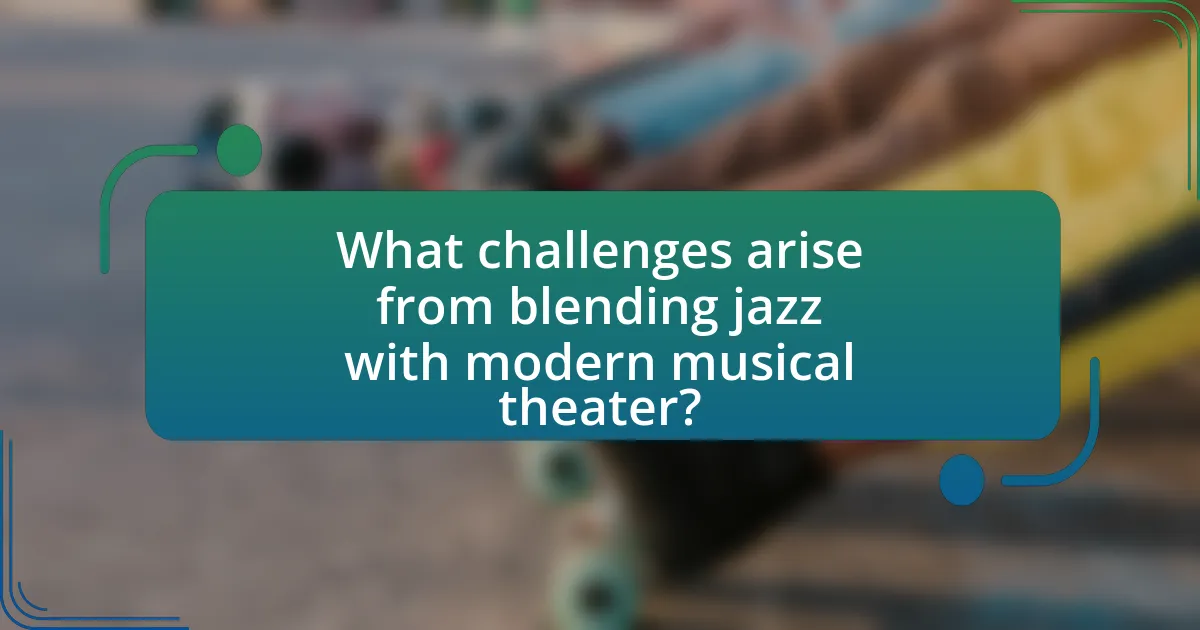
What challenges arise from blending jazz with modern musical theater?
Blending jazz with modern musical theater presents challenges primarily in the areas of stylistic integration and audience reception. The complexity of jazz rhythms and improvisation can clash with the structured nature of musical theater, which often relies on predictable patterns for storytelling. Additionally, audiences may have varying levels of familiarity with jazz, leading to potential disconnects in engagement. Historical examples, such as the mixed reception of “Shuffle Along” in 1921, illustrate how jazz-infused theater can struggle to find a balance between artistic innovation and mainstream appeal.
What are the potential pitfalls of incorporating jazz into musical theater compositions?
Incorporating jazz into musical theater compositions can lead to several potential pitfalls, including complexity in musical structure and audience accessibility. The intricate rhythms and improvisational elements characteristic of jazz may alienate audiences who are more accustomed to traditional musical theater forms, potentially limiting the show’s appeal. Additionally, the fusion of jazz with theatrical storytelling can create challenges in maintaining narrative coherence, as the emphasis on musicality might overshadow character development and plot progression. Historical examples, such as the mixed reception of “Shuffle Along” in 1921, illustrate how jazz-infused productions can struggle to balance artistic innovation with audience expectations, leading to commercial challenges.
How can composers balance jazz influences with traditional musical theater styles?
Composers can balance jazz influences with traditional musical theater styles by integrating jazz harmonies and rhythms while maintaining the narrative structure and melodic clarity typical of musical theater. This approach allows for the incorporation of syncopation and improvisational elements characteristic of jazz, which can enhance emotional expression without overshadowing the storytelling aspect central to musical theater. For instance, shows like “Chicago” and “Porgy and Bess” successfully blend these elements, demonstrating that jazz-infused arrangements can coexist with traditional forms, thereby enriching the overall musical experience.
What feedback do audiences provide regarding jazz-infused musical theater?
Audiences generally provide positive feedback regarding jazz-infused musical theater, appreciating its unique blend of musical styles and emotional depth. Many viewers highlight the energetic rhythms and improvisational elements characteristic of jazz, which enhance the storytelling and character development within the performances. For instance, productions like “Chicago” and “The Wild Party” have received acclaim for their innovative use of jazz, with audiences noting how the genre’s syncopation and expressive melodies contribute to a more dynamic theatrical experience. This positive reception is supported by box office success and critical reviews, indicating that jazz-infused elements resonate well with contemporary theatergoers.
How can composers effectively integrate jazz into their musical theater works?
Composers can effectively integrate jazz into their musical theater works by incorporating jazz harmonies, rhythms, and improvisational elements into their compositions. This approach allows for a dynamic and expressive musical landscape that reflects the emotional depth of the narrative. For instance, the use of syncopated rhythms and blue notes can create a distinct jazz feel, enhancing character development and storytelling. Historical examples include the works of George Gershwin in “Porgy and Bess,” where jazz idioms are seamlessly woven into the fabric of the score, demonstrating the genre’s ability to convey complex emotions and cultural contexts. Additionally, the inclusion of jazz ensembles and solo improvisation during musical numbers can further enrich the theatrical experience, providing opportunities for performers to showcase their artistry while engaging the audience.
What techniques can be used to blend jazz harmonies with musical theater melodies?
To blend jazz harmonies with musical theater melodies, composers can utilize techniques such as extended chord voicings, modal interchange, and syncopated rhythms. Extended chord voicings, which include seventh, ninth, and thirteenth chords, create richer harmonic textures that are characteristic of jazz. Modal interchange allows composers to borrow chords from parallel modes, adding unexpected colors to the musical theater melodies. Syncopated rhythms, often found in jazz, can enhance the rhythmic complexity of musical theater pieces, making them more dynamic and engaging. These techniques have been effectively employed in works by composers like Stephen Sondheim and Lin-Manuel Miranda, who incorporate jazz elements to create unique and compelling scores.
How can understanding jazz history enhance a composer’s approach to musical theater?
Understanding jazz history can significantly enhance a composer’s approach to musical theater by providing insights into improvisation, rhythm, and emotional expression. Jazz, which emerged in the early 20th century, emphasizes spontaneity and personal expression, elements that can be integrated into musical theater to create more dynamic and engaging performances. For instance, the use of syncopation and complex harmonies found in jazz can add depth to musical scores, allowing composers to craft more intricate and emotionally resonant pieces. Additionally, studying influential jazz figures, such as Duke Ellington and Ella Fitzgerald, can inspire composers to explore diverse musical styles and storytelling techniques, enriching the narrative and emotional landscape of their works. This historical context not only informs compositional techniques but also encourages a broader understanding of cultural influences, ultimately leading to more innovative and impactful musical theater compositions.
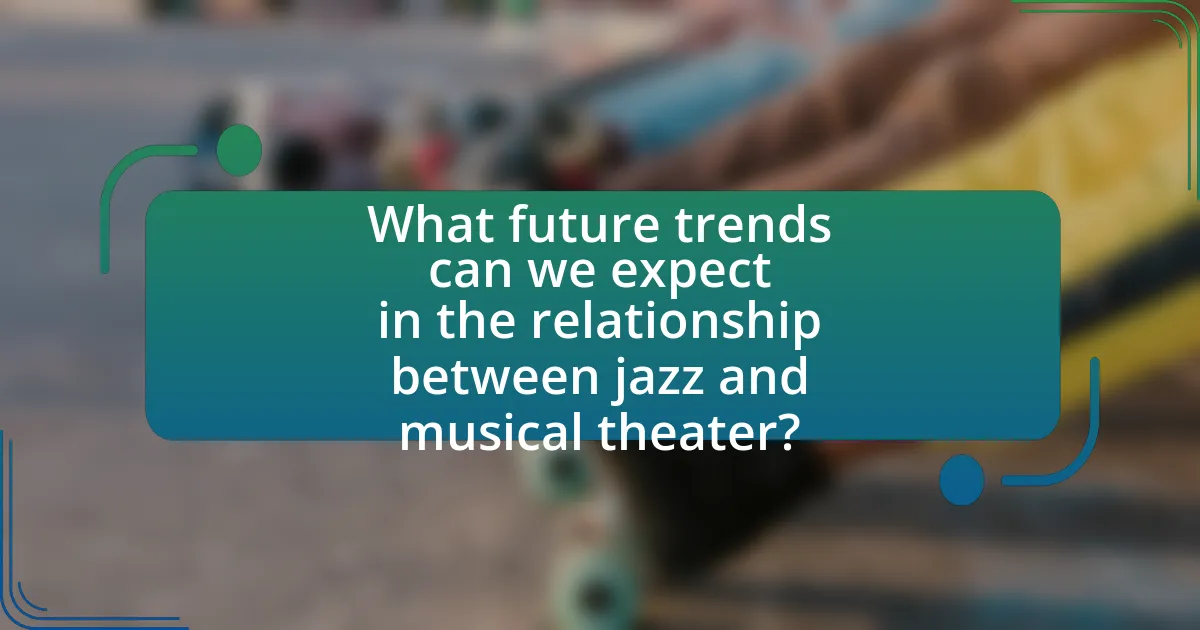
What future trends can we expect in the relationship between jazz and musical theater?
Future trends in the relationship between jazz and musical theater will likely include increased integration of improvisational elements and cross-genre collaborations. As musical theater continues to evolve, composers and choreographers are increasingly drawing from jazz’s spontaneous nature to enhance storytelling and character development. This trend is supported by the success of recent productions that incorporate jazz styles, such as “Hamilton,” which blends hip-hop with jazz influences, showcasing the versatility of jazz in modern narratives. Additionally, the rise of digital platforms allows for broader experimentation and fusion of jazz with other genres, further enriching the musical theater landscape.
How is the evolution of jazz likely to influence upcoming musical theater compositions?
The evolution of jazz is likely to influence upcoming musical theater compositions by introducing complex rhythms, improvisational elements, and diverse musical styles. As jazz has evolved, it has incorporated various genres, such as blues, funk, and hip-hop, which can enrich the musical vocabulary of theater composers. For instance, the incorporation of syncopation and swing rhythms from jazz can create a more dynamic and engaging score, appealing to contemporary audiences. Additionally, the improvisational aspect of jazz allows for greater flexibility in performance, encouraging actors and musicians to explore character emotions and narratives in real-time. This adaptability can lead to innovative storytelling techniques in musical theater, as seen in productions like “Hamilton,” which blends hip-hop and jazz influences to convey historical narratives.
What emerging artists are currently shaping the future of jazz in musical theater?
Emerging artists shaping the future of jazz in musical theater include musicians like Christian Scott aTunde Adjuah, who blends traditional jazz with contemporary influences, and vocalist and composer Jazzmeia Horn, known for her innovative vocal techniques and storytelling. These artists are redefining jazz’s role in musical theater by incorporating diverse styles and narratives, thus expanding the genre’s reach and appeal. Their contributions are evident in recent productions that feature jazz-infused scores and themes, showcasing the evolving landscape of musical theater.
How might technology impact the integration of jazz in future productions?
Technology will significantly enhance the integration of jazz in future productions by enabling innovative sound design and interactive performance experiences. Advanced software and hardware tools allow composers and musicians to blend traditional jazz elements with contemporary genres, creating unique soundscapes that appeal to diverse audiences. For instance, digital audio workstations (DAWs) facilitate seamless collaboration among artists, while live-looping technology can incorporate real-time improvisation, a hallmark of jazz, into theatrical performances. Additionally, the use of augmented reality (AR) and virtual reality (VR) can immerse audiences in jazz-infused narratives, making the experience more engaging. These technological advancements not only preserve the essence of jazz but also expand its reach and relevance in modern musical theater.
What practical tips can composers follow to successfully incorporate jazz into their musical theater works?
Composers can successfully incorporate jazz into their musical theater works by utilizing syncopation, improvisation, and jazz harmonies. Syncopation adds rhythmic complexity, making the music more engaging; for example, many jazz standards use off-beat accents to create a lively feel. Incorporating improvisation allows performers to express individuality, which is a hallmark of jazz, enhancing character development and emotional depth. Additionally, using jazz harmonies, such as seventh and ninth chords, enriches the musical texture and creates a distinct sound that resonates with audiences. These techniques have been effectively employed in successful musicals like “Chicago” and “Porgy and Bess,” showcasing the versatility and appeal of jazz in theater.
What resources are available for learning about jazz composition techniques?
Resources for learning about jazz composition techniques include books, online courses, and instructional videos. Notable books such as “The Jazz Composer’s Companion” by David Baker provide structured insights into jazz composition. Online platforms like Coursera and Udemy offer courses specifically focused on jazz theory and composition, often taught by experienced musicians. Additionally, YouTube hosts numerous instructional videos from professional jazz composers, which can enhance understanding through practical examples. These resources collectively support the study of jazz composition techniques effectively.
How can collaboration with jazz musicians enhance a musical theater project?
Collaboration with jazz musicians can enhance a musical theater project by infusing it with improvisational elements and complex rhythms characteristic of jazz. This collaboration allows for greater musical flexibility, enabling composers and performers to explore innovative arrangements and spontaneous interactions during performances. For instance, the integration of jazz harmonies and syncopated rhythms can create a more dynamic and engaging experience for the audience, as seen in productions like “Chicago,” which incorporates jazz influences to elevate its storytelling. Additionally, jazz musicians often bring a unique interpretative style that can deepen character development and emotional expression within the narrative, further enriching the overall theatrical experience.
